|
| | The Annunciation in Renaissance Art |
|
|
| Paying Attention |
The Uffizi Gallery in Florence contains
the defining collection of Renaissance painting. That's their mission.
Naturally,
it's the first stop on any tour to Florence, meaning that the
fourth or fifth painting any visitor will see is this alterpiece by
Simone Martini titled Annunciation with St. Margaret and St. Ansanus (1333).

When we saw it, we were captivated by
how explicit and dramatic it is. It piqued our interest in the Annunciation as a subject.
We kept our eyes open for others, and found dozens.
|
|
|
| The Story |
According to Christian tradition God sent the angel Gabriel to announce to the Virgin Mary that she would conceive
and become the mother of Jesus. She is at home, reading when the angel arrives.
The scene is underspecified in the Bible, so artists must interpret it.
In addition to Mary's home and her book, they sometimes
include angels, a dove, a lily in Gabriel's hand, and lines or rays from heaven towards
Mary, presumably implementing the conception. In almost all cases they imagine Gabriel
on the left, Mary on the right, and her wearing a red dress with a blue cape.
|
|
|
| 14th Century Art |
Studying Martini ... |
|
|
| Simone Martini |
Simone Martini's Annunciation (his brother-in-law Lippo Memmi did the peripheral people) has several
wonderful features. The first thing we noticed was the raised Latin inscription from Gabriel to Mary ave gratia plena
dominus tecum, meaning "Hail, full of grace, the Lord is with thee." It seemed to us an odd salutation, but maybe that's angel-speak.
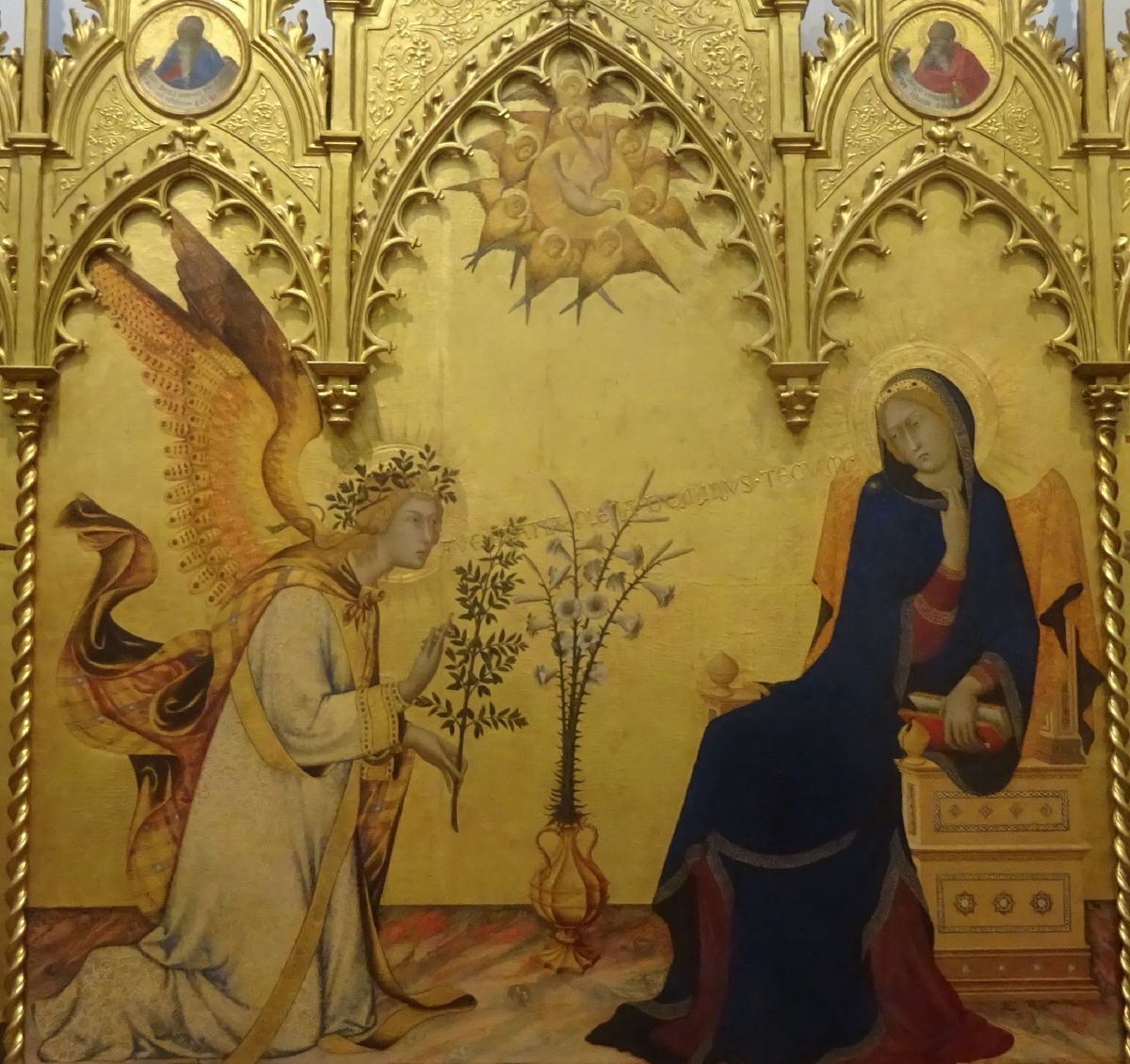
When we studied the artwork, focusing on Mary's body language
and facial expression, we couldn't tell if she was startled
by the arrival of an angel - most of us would be -
or if she was put off by the news she would be carrying a baby.
Also, we liked Martini's little
"sparrow angels" encircling
the dove. Notice that the dove is transmitting rays to Mary.
|
|
|
| 15th Century Art |
In contrast to the drama we saw in Martini's painting, two mid-15th Century artists
presented the idea that Mary wasn't particularly astonished by the arrival of Gabriel or the
news he announced. They were pioneers of the 'Whatever' club. |
|
|
| Alesso Baldovinetti |
Alesso Baldovinetti's 1447 Annunciation shows Mary taking the
presence of an angel and the news of the pregnancy in stride.
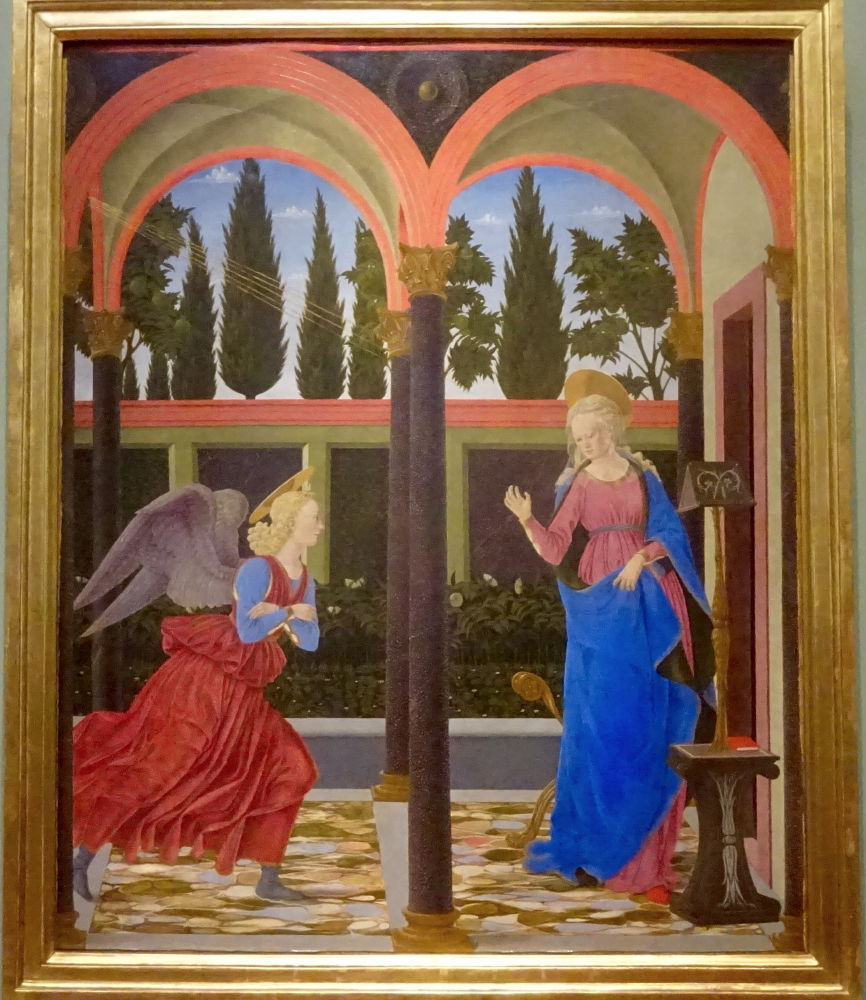
|
|
|
| Lorenzo di Credi |
The di Credi Annunciation (1485) carries the casual
formulation even farther than Baldovinetti. Gabriel seems to be asking a favor, and
Mary seems to be responding with "Got it." 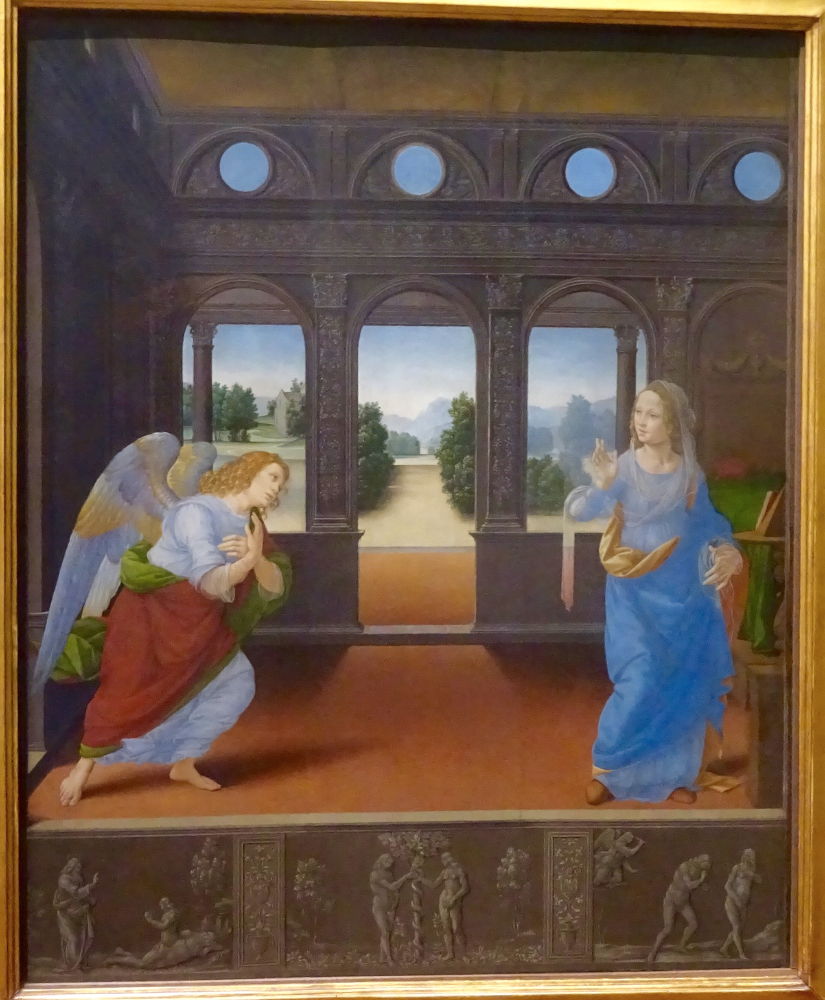
By making Mary so unemotional, these two artists emphasized her role as a faithful servent.
We would see others with the same perspective. |
|
|
| Leonardo Da Vinci |
Painting during the time of Baldovinetti and di Credi, Da Vinci imagined
an even more formal setting for his Annunciation (1475).
Mary, who lives in a very fancy house, seems unsurprised at Gabriel's visit, and appears
almost annoyed to be interrupted in the middle of her book, as if a servent had barged in.

Most significantly for a guy who speculated on human flight,
the wings Da Vinci gave Gabriel seem completely impractical.
|
|
|
| Alessandro Botticelli |
The Cestello Annunciation (1489) by Sandro Botticelli returned to
Martini's view that the situation was dramatic. He also benefitted from a century and a half
of art development. Botticelli has a more complex composition with emphasis on perspective,
evident in the floor tiles and the scene out the window.

Both Gabriel and Mary are rendered in exquisite detail. And, as
with Martini's Mary, Botticelli imagines that she was overwhelmed by the
event.
|
|
|
| |
Botticelli's earlier The Annunciation to Mary (1481) was a fresco in San Martino della Scala,
which was removed to the Uffizi and restored. It's huge - several meters across. 
Here rays are beaming from the door at left towards Mary, who, surprised in her bedroom,
seems overwhelmed almost to the point of collapse. (He toned it down a little in the
Cestello painting above.) Botticelli neutralizes the appearance
of an "invasion of privacy" by placing Gabriel, sporting lilies woven into his wing feathers,
well outside her room.
|
|
|
| 17th Century Art |
Add another century and realism reigns ... |
|
|
| Matthias Stomer |
Among the artworks at the Uffizi the award for the most credible rendering of
the Annunciation may go to Matthias Stomer, a Dutch painter who figured out how to do
candle light. His Annunciation (1620s) shows Mary
startled and somewhat perplexed by Gabriel's news. "Me?" 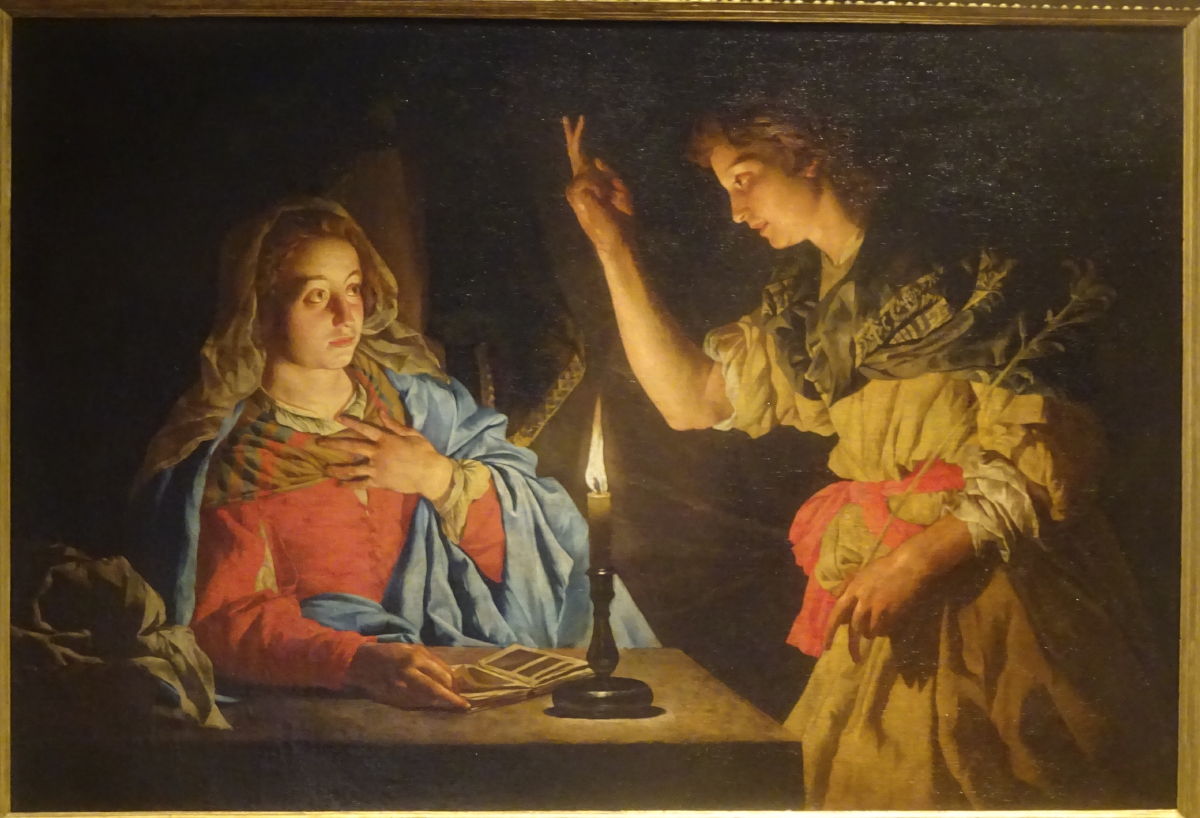
Stomer puts Mary on the left, and he doesn't waste paint on haloes, doves or details of Mary's home.
His focus is her face. Gabriel looks more like some dude who drifted in off the canal than an angel. The candle
light makes it a dramatic painting, but it's a formulation common people can relate to.
|
|
|
| 15th Century Art |
Returning to the first half of the 15th Century, we toured the Friary of San Marco
to see the work of il Beato Angelico, a/k/a Fra Angelico |
|
|
| Fra Angelico |
When he first arrived at the Friary (1408), Fra Angelico began as an illuminator, where he
embellished letters with tiny masterpieces, including the 'R' Annunciation
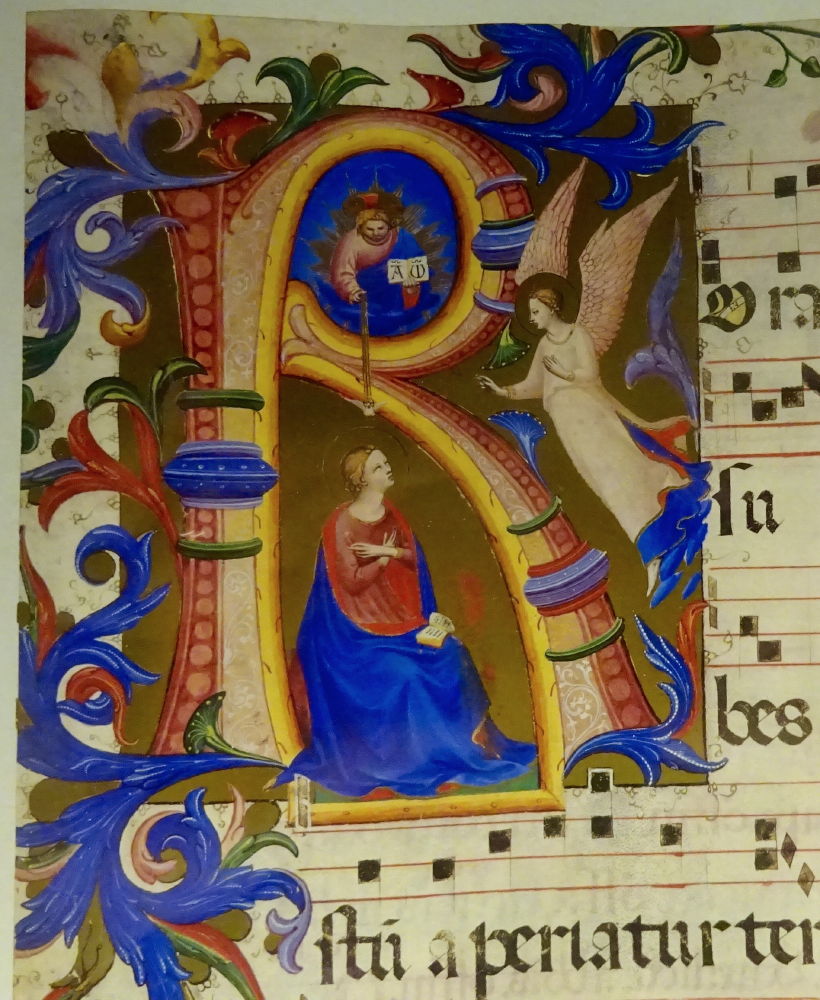
Mary shows a pose that is quite passive, though she has folded her arms across her
chest somewhat protectively, conveying some apprehension, perhaps. The rays from
Heaven and the dove that is delivering them are explicit.
As part of a series of small instructional paintings on the life of Christ - an illiterate populace
needed pictures to follow the stories - Fra Angelico did an Annunciation.
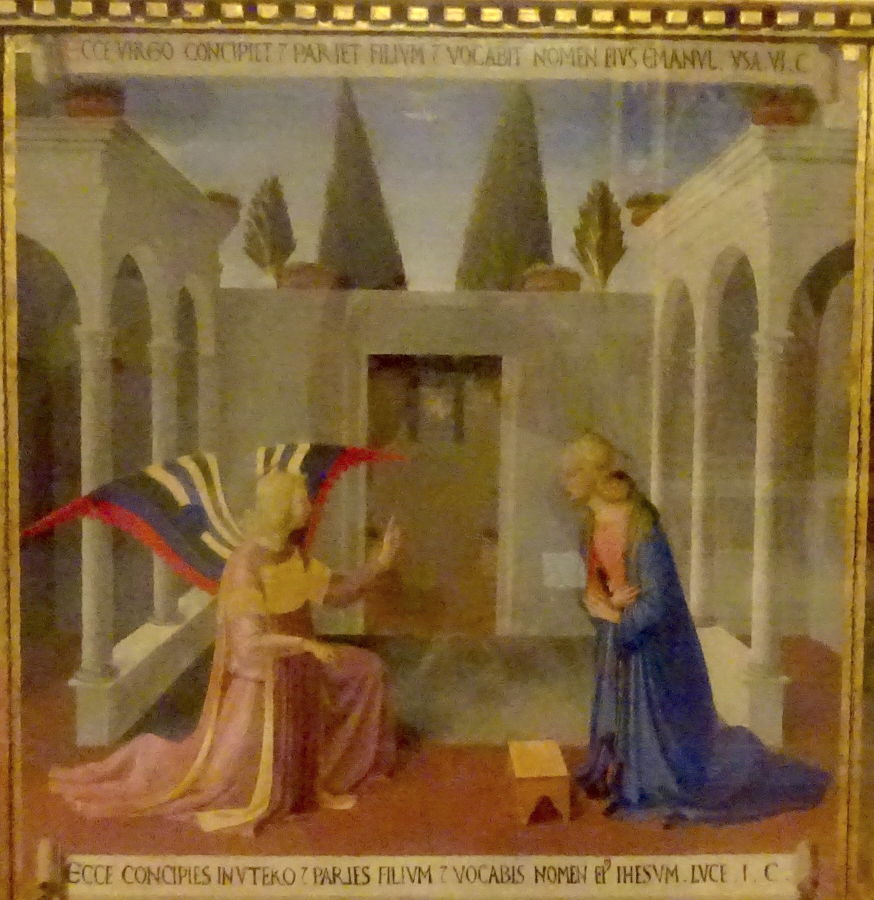
Mary is kneeling and leaning in, seeming to be following what Gabriel is telling her.
Most importantly, Fra Angelico has upgraded Gabriel's wings to full color.
Fra Angelico's all time most famous Annunciation is at the top of the stairs at San Marco
where the friars would repeatedly pass it. 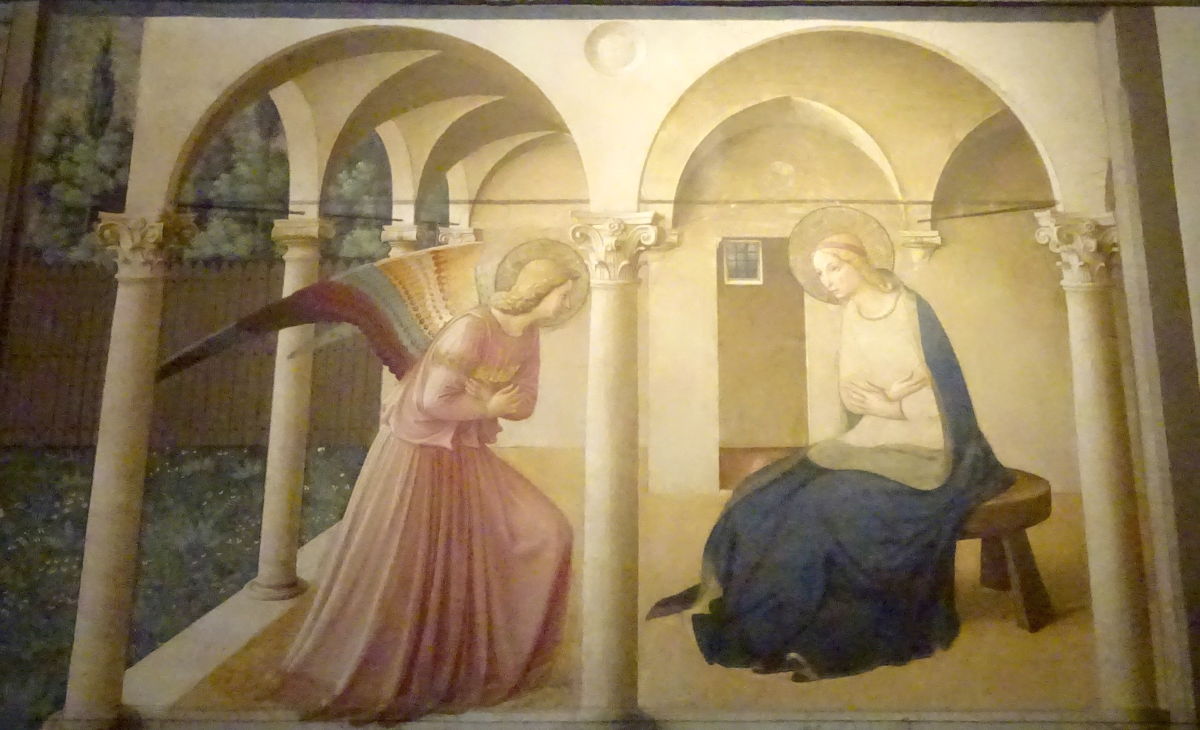
Again, we see Mary has her arms crossed,
though this time, Gabriel does too. Her attentive stare
carries with it somewhat more emotion - uncertainty, dread?
Fra Angelico also painted an Annunciation in friar cell #9. As with the others
Mary's arms are crossed, and Gabriel's are too. 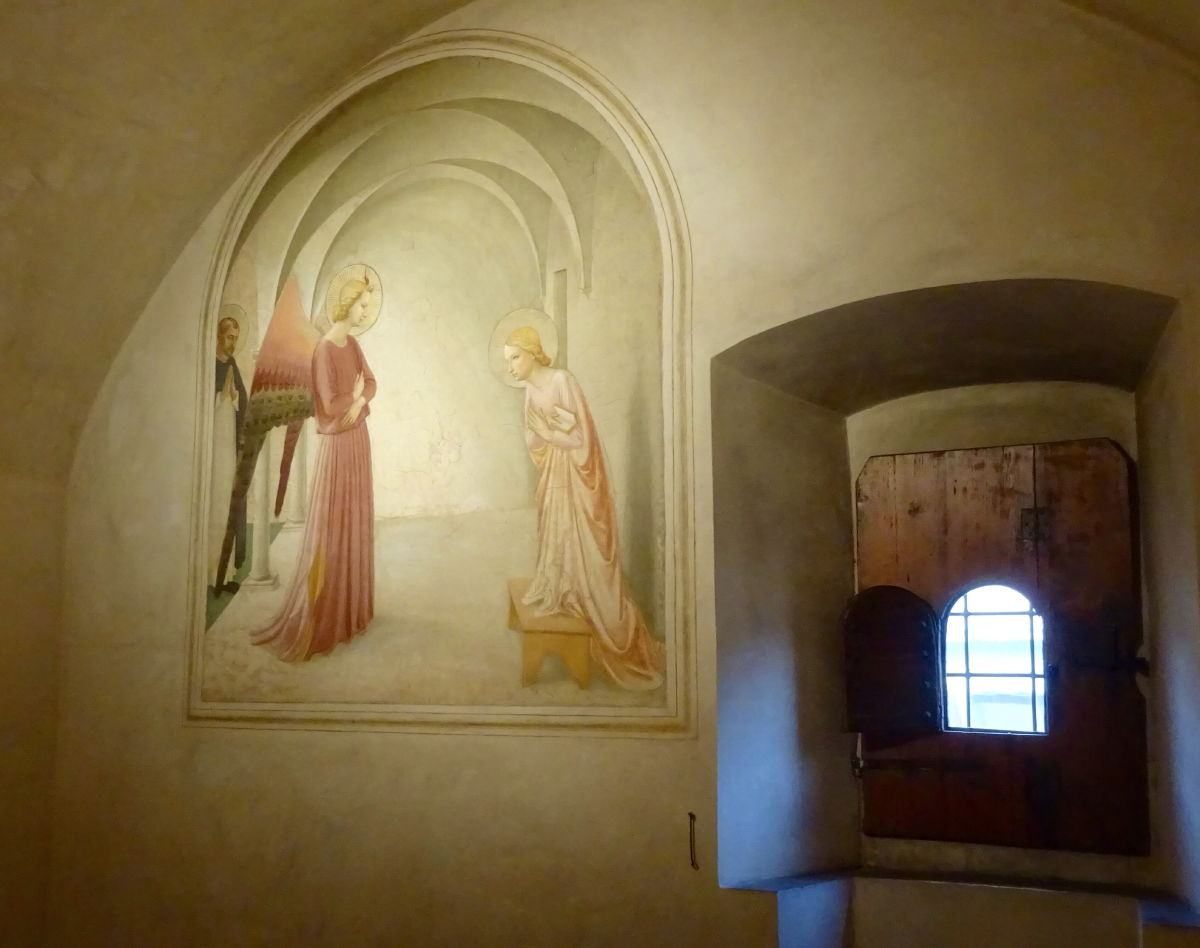
This time Gabriel is taller than Mary; her head is bowed showing respect, perhaps obedience.
On inspection, though, her look doesn't seem so
apprehensive as it does distracted. She appears not to be looking at Gabriel, but staring, lost in
thought.
Over his ten years at the Friary (1408-1418), Fra Angelico gave us four versions of the Annunciation.
Unlike Martini's Mary who seemed shocked, Fra Angelico imagined her in control. In fact
his work seemed to evolve to a deeper, more cerebral Mary with each version.
|
|
|
| 18th Century Art | |
|
|
| Anonymous |
And, of course, it's possible to tell the story of the Annunciation with inlaid stone

Following Fra Angelico's design ideas is always smart.
If you prefer to sculpt an Annunciation out of stone,
with dove or
without, don't forget the gold highlights. |
|
|
So, you get the idea ... we wandered around Florence and each time we saw a new Annunciation
we studied it in the context of those we'd seen. There are many. Some reprised ideas
from the masters above, and others formulated new ideas on how the moment might have looked
or the two principals might have interacted. Here, in no particular order, are others. We've added
some remarks, but at this point you're an accomplished Annunciation critic yourself. Enjoy!
|
| Taddeo Gaddi |
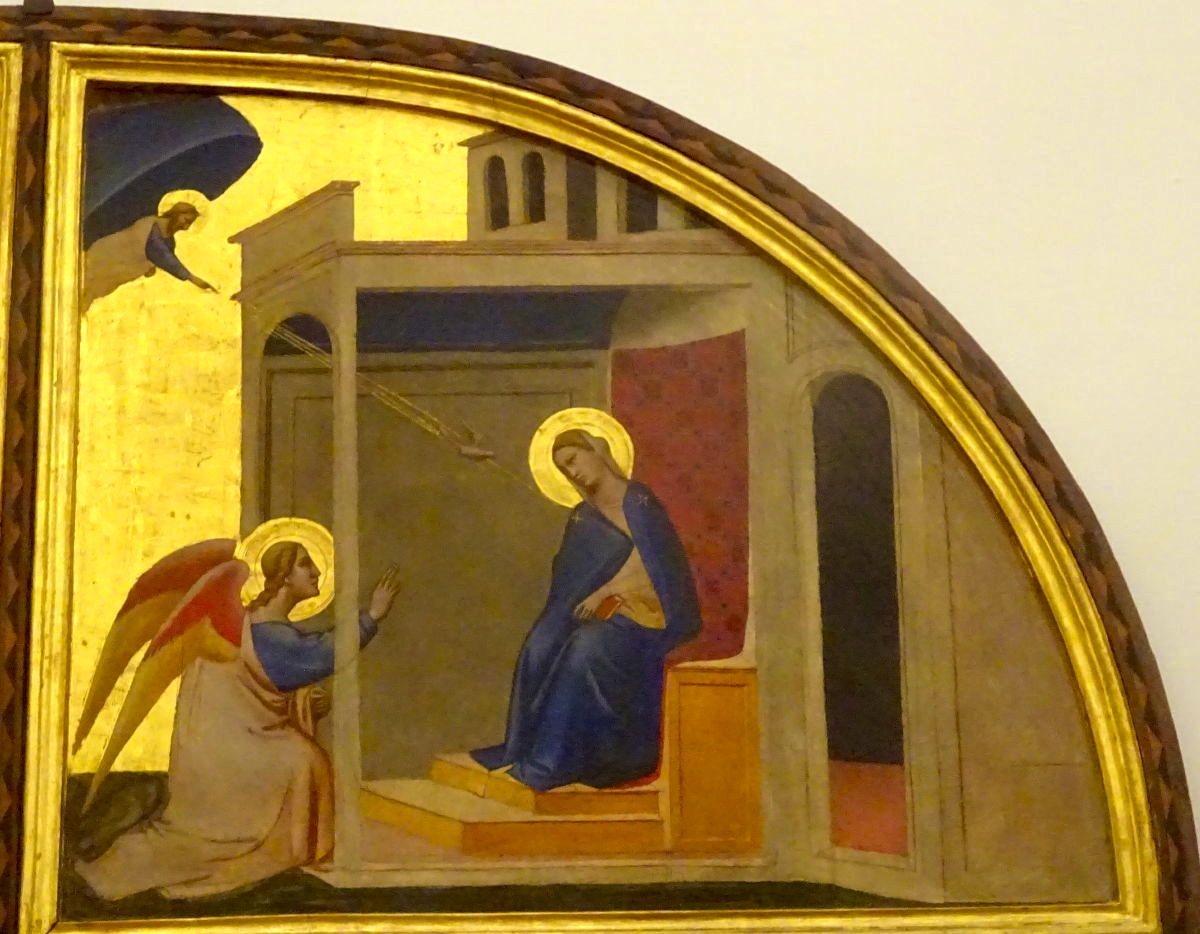
In his Annunciation of 1330 Gaddi
formulates a picture with all of the essentials, but with minimalist expression.
Gabriel conveys comfort and support while he announces to Mary what's happening. Mary is
sober and attentive. The rays from Heaven and the dove guiding them are explicit.
|
|
|
| Giovanni del Biondo |
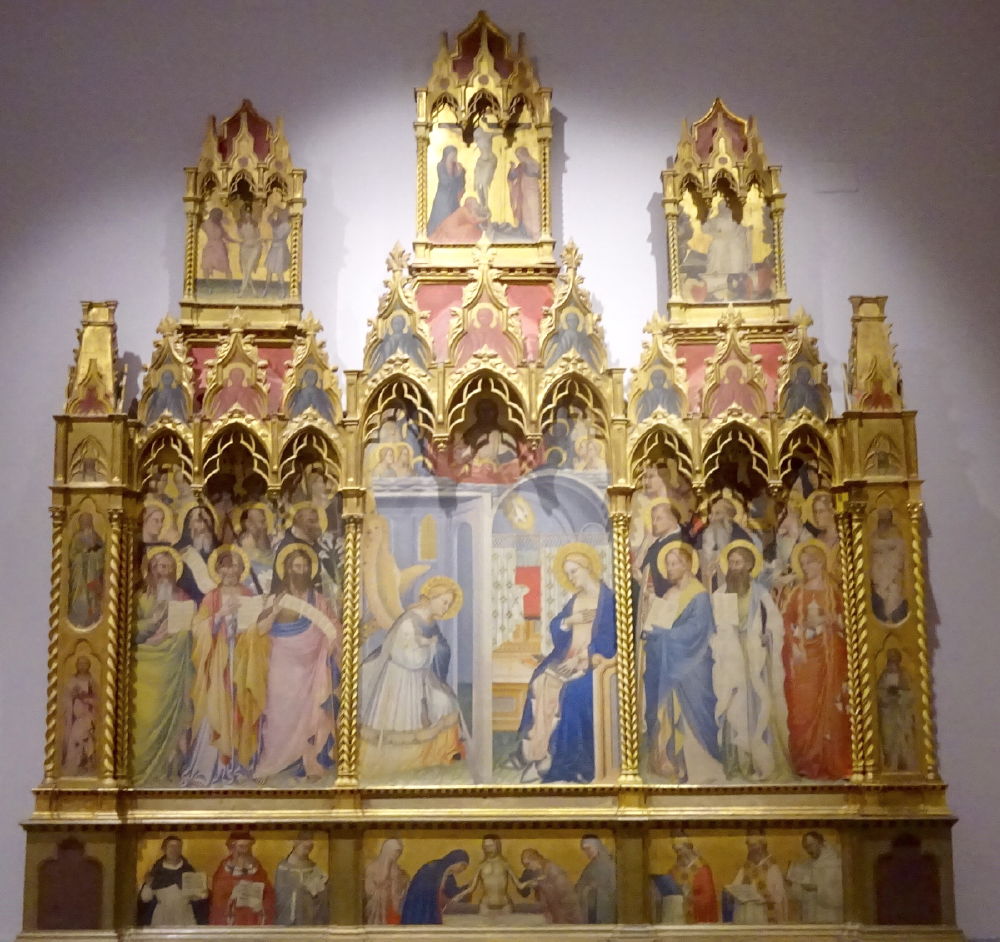
In 1385 Biondo completed this
impressive alter piece. Saints and other
dignitaries are looking on as a respectful Gabriel speaks and the dove races in at Mach 2 speed.
Mary, who has 3 books, seems lost
in thought from the announcement. The two do not make eye contact. Perhaps that's
where Fra Angelico got the idea.
|
|
|
| Unknown |
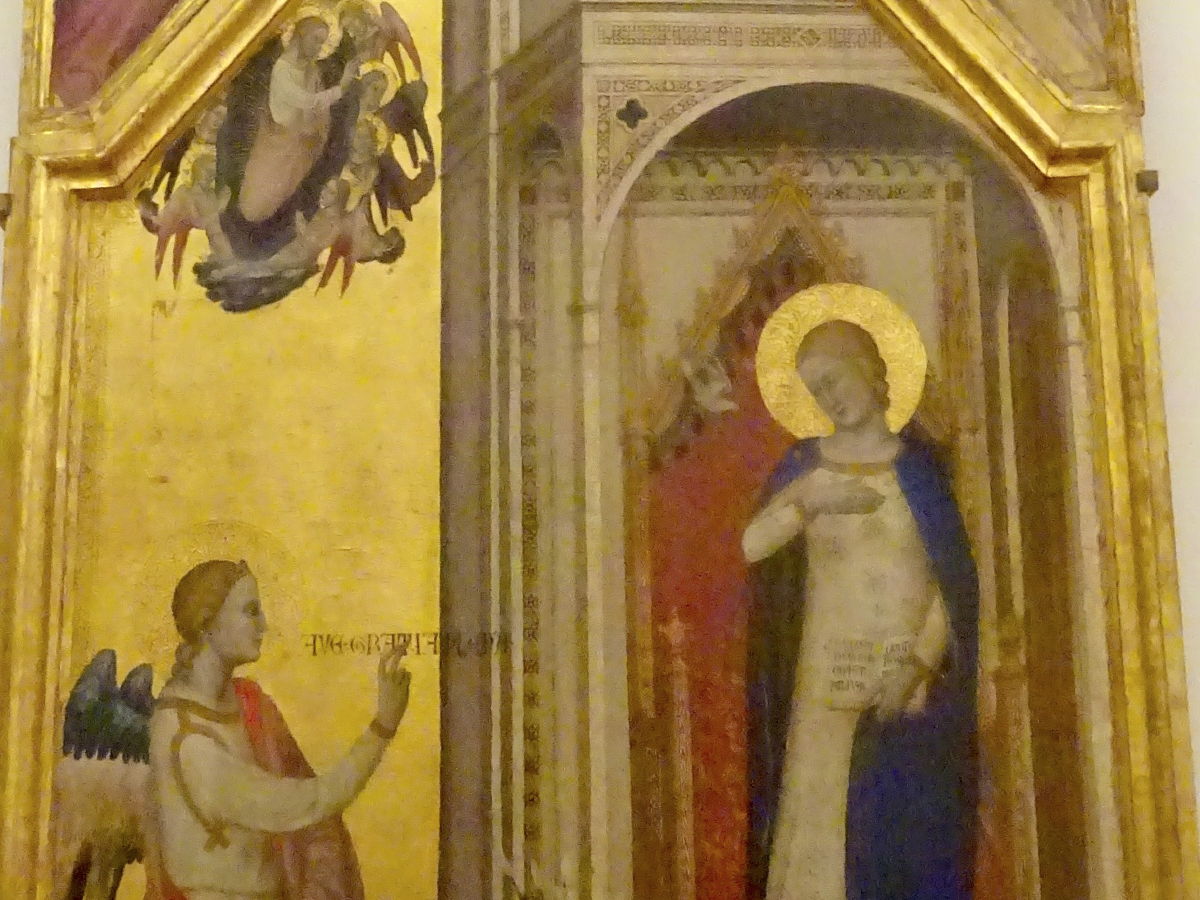
This unknown Florentine artist liked
Martini's idea of textual communication. From the
full painting, we see he borrowed the sparrow angels, too. But he dialed back Martini's
take on Mary's reaction to the news. He imagines a frown and possibly a small gasp of surprise.
|
|
|
| Anonymous |

The Basilica of Santa Croce has an Annunciation
embedded in the decoration high up on the right transept. We're uncertain what to make of
Mary's countenance. She's definitely in the "Whatever"
club, of course, because if you can levitate a book, listening to a angel or unexpectedly becoming a
mother are well within your capabilities. But, is she just a little curious about Gabriel?
|
|
|
| Alessandro Alori |

Alori has two Annunications hanging
in a too-dark-for-photography hall at the Accademia. His huge 1579 work
includes joyous cherubs frolicking and light beaming down from heaven. Gabriel, an angel of luxury,
brings a comfy cloud to kneel on. In contrast to this hummy scene Mary, apparently interrupted
in the midst of doing laundry, is overwhelmed, possibly falling on her knees at the news.
|
|
|
| Alessandro Alori |

Reconsidering the Annunication in
1603 Alori seems to have decided, "Beaming light is good, but I
need less Heaven and more surprise." Gabriel is giving Mary the
straight announcement without sugar coating it. Mary for her
part
now seems less overwhelmed and more concerned, thinking, perhaps, "OMG. No way is this going to fit into my schedule."
|
|
|
| Fra Filippo Lippi |

In this ca. 1440 Lippi Annunciation in San Lorenzo,
Gabriel has brought along two assistant angels. This larger crowd seems to press in
on Mary, who gestures for him to back off. And given the message
he's announcing, can she be blamed for wanting a little space?
|
|
|
| Unknown |

This Annunciation has all of the components of the story right down
to the comfy cloud for Gabriel to kneel on. Mary, who is beautifully highlighted, has a rational, pragmatic look as
she tries to size up the angel. She seems to be saying, "You're speaking in lilies ... explain that again."
|
|
|
| Lorenzo Monaco |

This Monaco triptych is another case where Mary is
slightly taken aback, turning her body away from Gabriel. More curious is Gabriel who looks quite
feminine with narrow shoulders and broader hips. Compare with the woman at left. Painted between
1408-1418, this feminine look is reminescent of Fra Angelico's Gabriel in his
"Cell #9" Annunciation painted in the same decade.
|
|
|
| Ghirlandaio |

In Santa Maria Novella there is a Ghirlandaio Annunciation
which is gorgeous, but like many of our photos isn't as crisp as it deserves. Gabriel comes across as somewhat
obsequious, but he's talking to Jesus' mother after all. Ghirlandaio's Mary is unquestionably in the 'Whatever' club.
Also, it seems she may have enjoyed a few too many honey-covered dates.
|
|
|
| Unknown |

This is a simple version of the Annunciation using Fra Angelico's
crossed arms postures. But, it is sufficiently simple that we
suspect Mary might not buy the story ... "Where are the lilies?
Where's the dove? Show me your ID."
|
|
|
| Unknown |
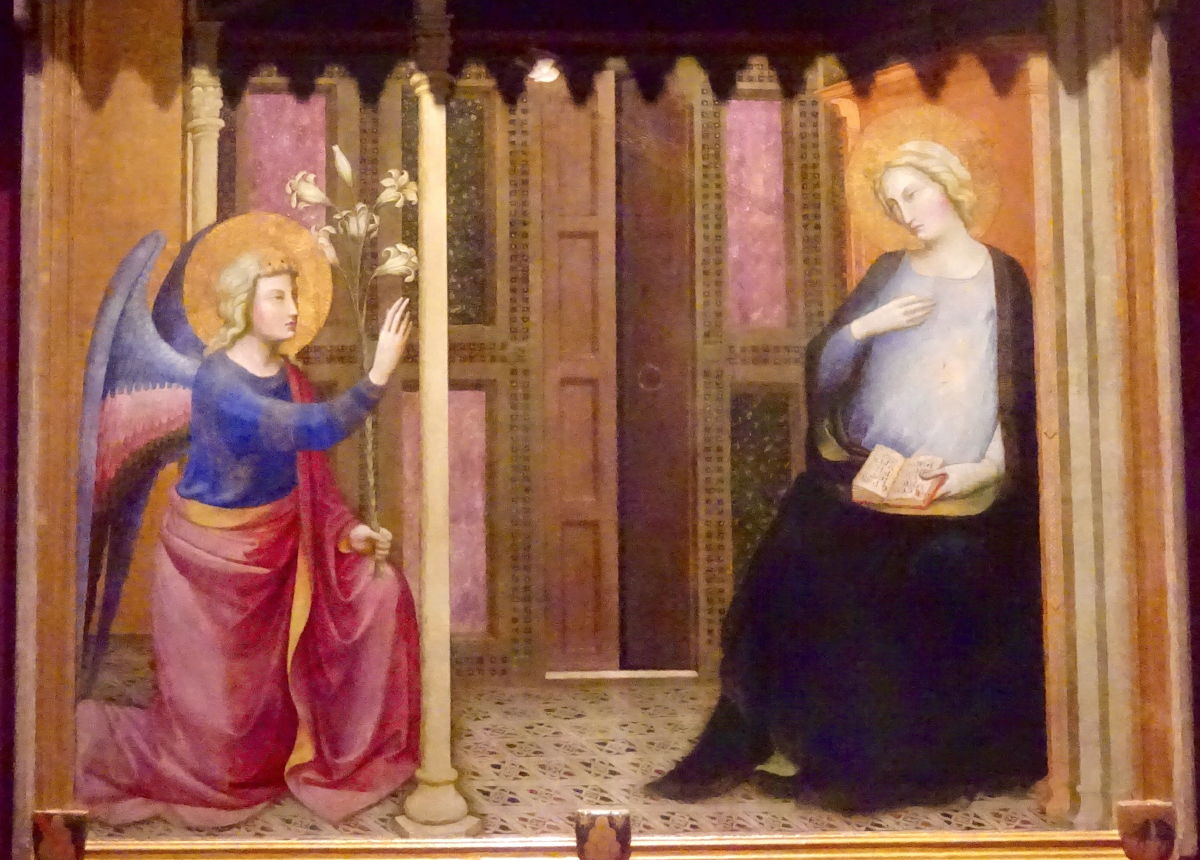
One of the Accademia Gallery's Annunications shows Mary
wearing a black cape, rather than the standard red dress and blue cape. Actually, it's Gabriel with the red and
blue combination. He keeps his distance, which may be limiting his persausiveness. Mary's frown gives off the
sense she is not yet signed up.
|
|
|
| Santi di Tito |
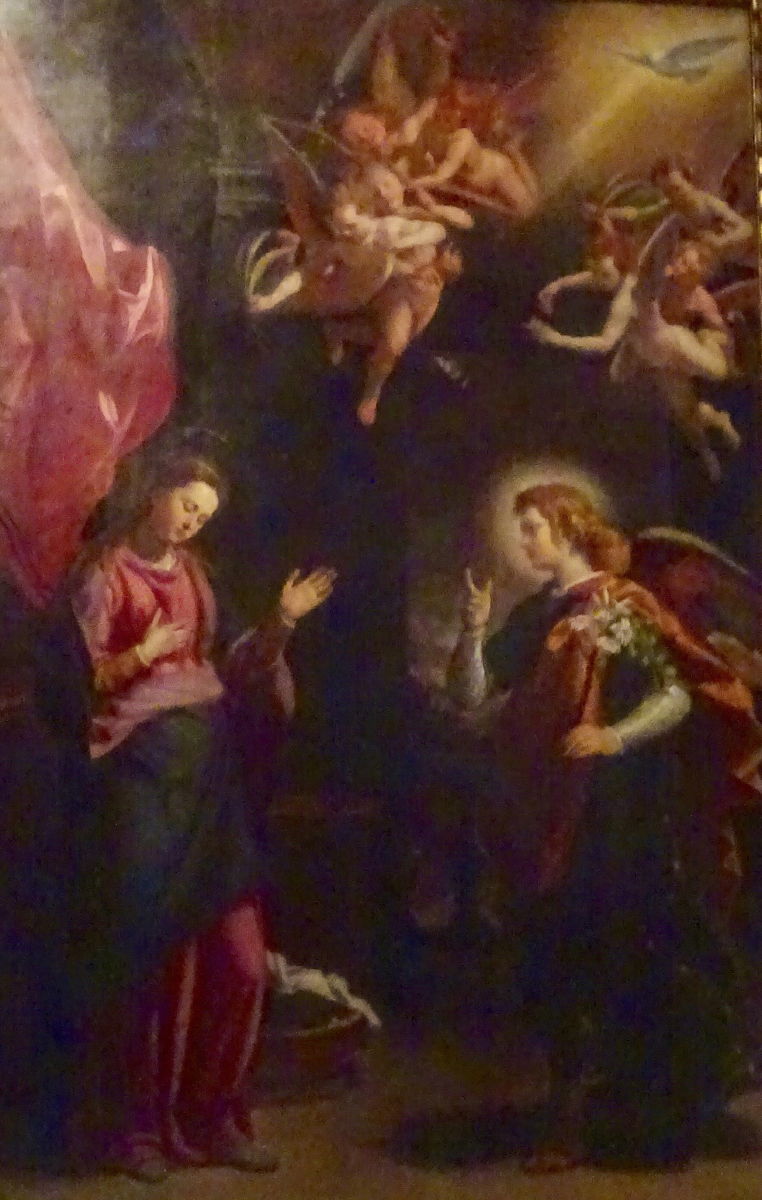
Another masterpiece, this one by di Tito (1603), contains all of the
standard elements
plus, Mary is on the left. Gabriel is unquestionably a guy, and
the mystery of the moment is enhanced by some
mysterious pink fabric behind Mary. Her pose truly seems to say,
"I'm so unworthy," and that may make di Tito's Annunciation perfect.
|
|
|
| Unknown |

Not unreasonably, we usually consider the Annunciation from Mary's
point of view.
But, at least one artist thought about how it might look in
Gabriel's imagination. He's all wings and lilies and fancy duds. In
his view, if Mary shoots the messenger, he hopes it's in IMAX.
|
|
|
| |